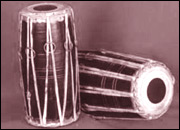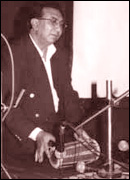Instrumental
Madal : Madal is basically a PAHADI instrument used with folk tunes of Nepal. Played in North East hilly area of India covering Darjeeling, Kalingpong, Assam and Nepal area. These areas have very specific soft sounding folk music, which resembles the sound of hills and valley’s of the area.
 The Instrument : Madal is a soft sounding rhythm instrument, which is played with main rhythm instrument like dhol etc. The Madal looks like a smaller version of “Dholki” (a popular rhythm instrument of Maharashtra) or a “Pakhwaj”. It has two ends, which can be played with hands. Both sides have different tones, a high tone from smaller side and low tone from the bigger side. The chaat is played with fingers as in tabla or pakhwaj and the bigger end is also played with fingers unlike in tabla or pakhwaj. The main problem is gripping this instrument while playing due to its size and lightweight.
The Instrument : Madal is a soft sounding rhythm instrument, which is played with main rhythm instrument like dhol etc. The Madal looks like a smaller version of “Dholki” (a popular rhythm instrument of Maharashtra) or a “Pakhwaj”. It has two ends, which can be played with hands. Both sides have different tones, a high tone from smaller side and low tone from the bigger side. The chaat is played with fingers as in tabla or pakhwaj and the bigger end is also played with fingers unlike in tabla or pakhwaj. The main problem is gripping this instrument while playing due to its size and lightweight.
The Pancham Effect : It was in 1970-71 when Pancham signed his first movie with Dev Anand ‘Hare Rama Hare Krishna’. Most of the movie revolved around the locations in Nepal. Pancham wanted that Pahadi effect for the songs and the background music. The song “O re ghungaroo ka bole” had the exact Pahadi effect and whole of background music of HRHK was based on Madal. Since then Pancham started using madal in all his songs. In any case he was hooked on to the sound of “Duggi”, another similar sounding instrument. Duggi and Madal are similar in sound except that Duggi has sharp sound and Madal has a soft tone. During 1971-86, he has used Duggi and Madal both in most of the songs.
 The Player : Ranjit Gajmer allies “Kancha” came to Mumbai in search of work with has Madal in bag. Mr. Manohari Singh, Pancham’s assistant showed Pancham the sound of Madal. It was then that Madal and Kancha both became permanent part of his music.
The Player : Ranjit Gajmer allies “Kancha” came to Mumbai in search of work with has Madal in bag. Mr. Manohari Singh, Pancham’s assistant showed Pancham the sound of Madal. It was then that Madal and Kancha both became permanent part of his music.
Kancha played for Pancham in practically every song thereafter. He created his own style and till date most players are following the same style. “Hum dono do premi” from film Ajanabee is such song where the whole rhythm is played on Madal. Though the picturisation of this song is done on the train, using madal as main rhythm was part of pancham’s experiment. “Hoga tumse pyara kaun” from Zamane ko dikhana hai was a repeat success of this experiment. Songs like “Dil mein jo baate hai” from Joshila gave exact feel of tea gardens of Assam where it was shot. Madal has given perfect Pahadi touch to the song.
In Sholay’s title music the feel of village has been created with madal and a rich tone of Madal with Tabla and Duggi has enhanced the whole song “Tere bina jiya jaye na” from Ghar. Till end upto ‘1942 a Love Story’, Pancham used Madal and Kancha in his songs. Separating Pancham’s songs and Madal is virtually impossible.
Reso Reso –
Reso Reso or popularly called as Reso is basically an African Instrument. Some call it as Scraper. This instrument is part of side rhythm and used to give extra sharpness or add treble to the music at foot tapping speed. The Instrument Reso is made of hollow bamboo and it is in form of pipe. Scales are carved on the bamboo at defined distance.
When played with any flat strip of hard material like comb etc, it gives very sharp notes (approx. 10 to 12 KHz). This is required to enhance or help the main rhythm instruments.
The Pancham Effect : Right from the beginning Pancham wanted to do something different in his music. The major change in the music industry he made was to separate the side rhythm from the main rhythm and give them an individual mike..
Earlier all side rhythmus like Reso, Khanjiri, Kabbaz, Sticks etc. used to played together sitting behind the main rhythm artists. From Teesari Mazil, Indian music lovers started listening to different sound pattern. Listen to Aja aja main hoon pyar tera, Sona re sona, O hasina zulfon wali and other songs of other music directors in the same year (1965) and you will realize the separation of side rhythm and main rhythm. Reso became part of pancham’s music from this movie onwards.
Reso became most popular with song “Mere samne wali khidki mein” from Padosan. The song starts with Kishor’s alap and after 7 bars, the sound of Reso grips the entire rhythm of the song.
Generally Reso is supposed to support the main rhythm but Pancham made it sound otherway round. He made Reso as main instrument and other rhythmus like Drums, Congo etc follow the Reso. In the movie Keshto Mukherjee is shown playing a Zadoo (broom) and comb which is actually a Reso played with comb. The song was super hit and so was Reso.
The Player : Pancham had many gems in his orchestra and one of them was Mr. Amrutrao Katkar or popularly known as Amrut kaka. Amrutrao was actually a tabla player but Pancham and his main rhythm section head Shree Marutirao Keerji made him a Reso player. He developed his own style and even today Amrutrao is known as best Reso player in India. A tabla player who has been playing tabla off and on in Pancham’s group became the master of Reso and Pancham extracted the best out of him. Listen to the song “Mera naam hai shabnam” from Kati patang, the whole song has only Reso and bongo and with a great timing. Also the song “Sach mere yaar hai” from Sagar also start with Reso.
Amrutkaka made a change in Reso 1982-83 in a song “Jaane Jaa, Nisha Nisha” from Sanam Teri Kasam. He made a metal Reso instead of a traditional bamboo and played during the second interlude music (M2). Reso being African instrument goes very well with fast, catchy, cabaret type of songs. Pancham used reso even for almost all classical based songs who’s main rhythm is tabla. Songs like “Piya Bawari”, “Sawan ke Jhule Pade”, “Mere Naina Sawan Bhado”, etc. Pancham knew how to use his instruments and his Aces to get the best melody with foot tapping rhythm.
»
